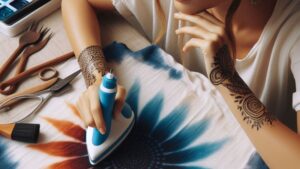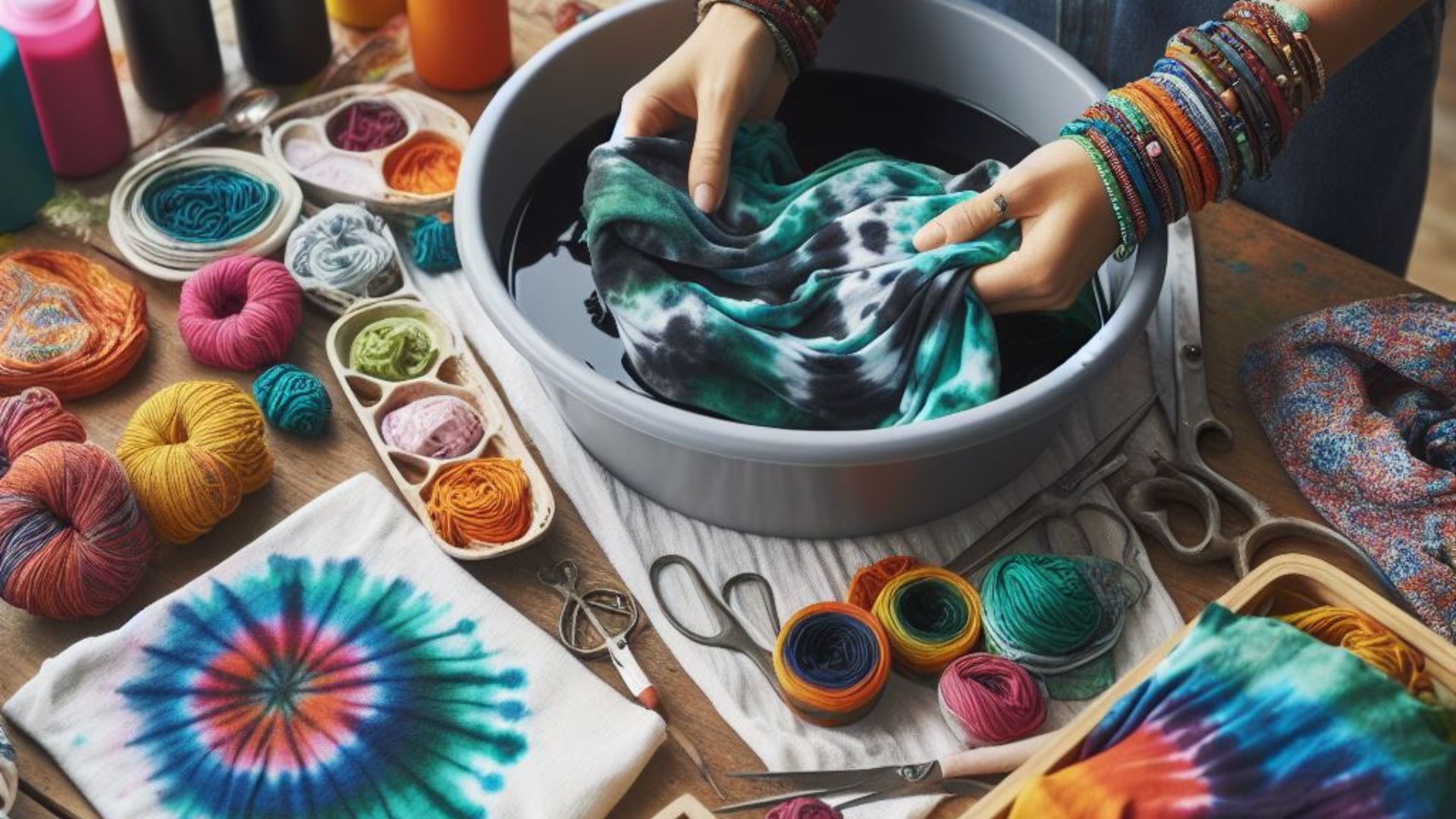Tie-dyeing is a fantastic way to add vibrancy and personality to both shirts and various fabrics. While the core principles remain the same, there are some nuances to consider when working with different materials. Let’s explore specific techniques for tie-dyeing shirts versus fabrics to ensure your creations turn out brilliantly.
1. Material Matters
Shirts:
When tie-dyeing shirts, cotton-based fabrics like t-shirts or tank tops are commonly used. Cotton absorbs dye well, allowing vibrant colors to pop. Pre-wash your shirt to remove any sizing that might hinder the dye absorption process. Keep in mind that shirts often have seams and folds that might affect the dye application.
Fabrics:
For fabrics other than shirts, like scarves, pillowcases, or even canvas bags, consider the material composition. Fabrics made of natural fibers like cotton, linen, or rayon absorb dyes similarly to shirts. However, synthetic fabrics such as polyester may require special dyes formulated specifically for synthetics.
2. Dye Application Techniques
Shirts:
Shirts offer a flat surface but also present unique challenges due to their construction. Consider folding or scrunching the shirt in various ways to create patterns. Popular techniques include the spiral, accordion folds, or even simple crumpling. Apply the dye evenly while ensuring it penetrates folds and layers for a vibrant outcome.
Fabrics:
With fabrics other than shirts, you might have more flexibility in terms of folding and tying techniques. Experiment with accordion folds, bullseye patterns, or intricate pleating for diverse and eye-catching designs. Remember, the way you fold and secure the fabric determines the final outcome, so embrace creativity!

3. Dyeing Process
Shirts:
After applying the dye, seal the shirt in a plastic bag or wrap it in plastic wrap to keep it moist. Let it sit for the recommended time (usually several hours) to allow the dye to set. Rinse the shirt thoroughly until the water runs clear, then wash it separately to prevent dye transfer.
Fabrics:
The dyeing process for fabrics follows a similar pattern. Once the dye is applied, enclose the fabric in a plastic bag or wrap to maintain moisture and allow the dye to set. The duration may vary based on the dye type; follow the instructions provided with your dye kit. Rinse the fabric thoroughly and wash it separately before use.
So,…
Tie-dyeing shirts and fabrics involves similar steps but may require slight adjustments based on material and structure. Remember to:
- Choose appropriate materials.
- Apply dye evenly and consider the fabric’s construction.
- Follow specific dyeing processes to ensure vibrant and lasting results.
Experimentation is key. Embrace creativity and have fun exploring various folding and tying techniques. Whether it’s shirts or fabrics, tie-dyeing is a delightful way to express your unique style.
For more detailed instructions and ideas, check out these resources:
Get ready to infuse color and creativity into your wardrobe and home with these tie-dye techniques
Enhancing Your Tie-Dye Mastery
Tie-dyeing is a delightful art form that offers endless opportunities for creative expression. Whether you’re diving into this craft for the first time or seeking to elevate your skills, let’s explore further tips and tricks to enhance your tie-dye mastery!
4. Color Mixing
Shirts:
When dyeing shirts, consider color combinations that complement each other. Experiment with primary colors to create secondary shades or mix ready-to-use dye colors to achieve your desired palette. Apply different hues strategically for striking effects.
Fabrics:
Similar to shirts, mix and match colors thoughtfully for fabrics. Consider the intended use of the fabric – whether it’s for home decor, apparel, or accessories. Bold, contrasting colors can make a statement, while softer, analogous tones can create a more harmonious look.
5. Dye Application Tools
Shirts:
For shirts, using squeeze bottles or spray bottles can provide precision in dye application. This is especially helpful when aiming for specific patterns or intricate designs. Brushes or droppers can also be useful for smaller details.
Fabrics:
With fabrics, consider using different tools for unique effects. Try using larger brushes for broader strokes or even rubber bands to create patterns distinct from those achieved with shirts. The type of tool used can significantly impact the final design.
6. Setting and Curing
Shirts:
Once the dye is applied, heat can help set the colors in shirts. Consider using an iron or placing the shirt in a dryer on a high-heat setting to heat-set the dye. This step helps the colors stay vibrant even after washing.
Fabrics:
Fabrics might require different setting methods depending on the material. Some dyes might require heat setting, while others might recommend air curing. Follow the specific instructions provided with your dye kit to ensure long-lasting colors.
Conclusion
Mastering tie-dyeing involves experimentation and embracing the artistic process. Don’t be afraid to explore different color combinations, dye application methods, and setting techniques. Each attempt brings new discoveries and unique results.
Remember, the essence of tie-dyeing lies in creativity and individuality. There are no strict rules – let your imagination run wild! Whether you’re revamping your wardrobe, creating bespoke gifts, or adding flair to your living space, tie-dyeing is an enjoyable way to infuse color and personality.
To further enrich your tie-dye journey, dive into these resources for inspiration and guidance:
Equip yourself with knowledge and let your creativity shine through vibrant patterns and hues
Comparison tabular
| Aspect | Tie-Dyeing Shirts | Tie-Dyeing Fabrics |
|---|---|---|
| Material | Cotton-based fabrics; pre-wash recommended | Consider fabric composition (natural/synthetic) |
| Dye Application | Apply dye evenly; consider seams and folds | More flexibility in folding and tying techniques |
| Techniques | Spiral, accordion folds, crumpling | Accordion folds, bullseye patterns, pleating |
| Dyeing Process | Seal in plastic; rinse thoroughly | Similar process; duration may vary based on dye |
| Color Mixing | Experiment with primary colors; mix shades | Thoughtful color combinations for intended use |
| Application Tools | Squeeze/spray bottles, brushes | Variety of tools; brushes, rubber bands, etc. |
| Setting and Curing | Heat set with iron or dryer | Specific methods based on dye and fabric type |
This table highlights the nuanced differences in tie-dye techniques between shirts and various fabrics, helping you navigate the unique aspects of each when indulging in this colorful craft!
wrapping up
Tie-dyeing offers a vibrant canvas for your creativity, whether you’re transforming shirts or exploring a range of fabrics. Embrace the uniqueness of each material, experiment with colors and techniques, and let your imagination guide your designs. Remember, there are no limits to what you can create with tie-dye!
By understanding the specific considerations for shirts versus fabrics, you’ll craft stunning, personalized pieces that reflect your style and personality. Dive into this colorful world, explore various folding methods, play with a spectrum of colors, and enjoy the joyous journey of tie-dyeing!
So, gather your materials, unleash your creativity, and infuse the world around you with bursts of color and artistry through the wonderful world of tie-dye!

For over a decade, I’ve been Mike, an artist, crafter, and designer deeply immersed in the Croc world. I thrive on crafting unique, size-inclusive patterns, fostering creativity, and sharing them on ktforum.com. My designs aim to ignite your creative spark and delight you, ensuring clarity and ease of use through rigorous testing. Join me in expressing your creative flair and showcasing your craft with joy.
Related Posts
- Tie-Dye Guide: Rinsing Techniques for Vibrant Creations
Tie-dyeing is a colorful and creative way to breathe life into your clothing or fabrics.…
- Understanding Tie-Dye Settling and Mixing with Other Dye Projects
Tie-dyeing is a vibrant and creative way to infuse life into fabrics, but ensuring colors…
- Reviving Your Tie-Dye: How to Reapply Dye for Better Results
Tie-dye projects are a blast, but sometimes the colors don't pop as expected due to…
- Accelerating the Tie-Dye Setting Process: Hairdryer or Fan?
Tie-dyeing is an art form that’s not just about colors; it’s about patience and precision.…

